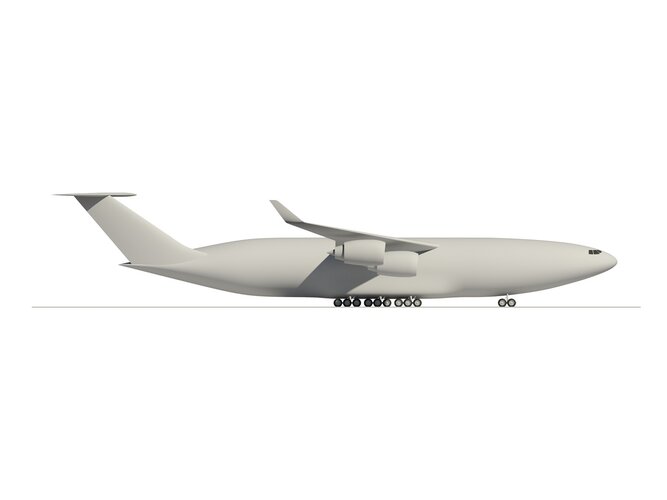- Joined
- 11 March 2012
- Messages
- 3,247
- Reaction score
- 3,176
Because a design challenge makes more fun with unusual approaches, I would like to propose a design which is a bit out of the box. My idea fairly conventional with some not so usual features. My idea that the resistance of very heavy plane will always be dominated by the induced drag and not by the parasitic drag. The design should therefor focus on maximum lift at take off and a lightweight structure, even if this will lead to higher parasitic drag. The amount of load largely depends on the take-off length on an ordinary runway, therefor the plane should be equipped with very strong turbo prop propulsion, (I added 6 propellers, so it will look automatically very powerfull ;-) .
Heavy load planes already do have something almost like stub wings at the bottom to house the landing gear (e.g. the A400m). In my design, these are more wider, so that they can create a ground effect. It is known, that these small wings helped a lot to lift the flying boats out of the water and Ecranoplanes used something quite similar for all of their lift. These stub wings are not effective in cruise flight, but they do help to get airborne and push the plane from the runway. On the other hand, these wings could also be used to produce downforce (by flaps, see the pics), so that the emergency breaking capabilities should improve. To switch between positive and negative lift, two different flap systems are needed, one aft for creating static pressure between the stub wings and the ground and one in the front to provide downforce when needed. If breaking is improved, the useful runway length can be increased which helps to take off with a heavier load. For take-off, the ground effect take-off flaps should extend at the beginning of the rotation, so that the maximum vertical acceleration can be achieved. By doing so, the rate of climb in the very early starting phase should be increased significantly, so that any nearby obstacles after the runway can be passed safely. Even if the additional ground effect of the stub wings is almost gone after reaching a flight high of about 5 m, the initial higher climb rate and steeper take off can make an important difference in the most critical part of the flight.
Since the stub wings take the load of the landing gear at hard landings, they can carry some of the main wing lift load during flight, so that a strut connection between them helps to reduce the root moment of the main wing and enables a higher wingspan (shorter take off, less induced drag). Struts can produce considerable amount of drag, but this depends very much on the angle, in a nearly rectangular angle to the main wing, as proposed here, this will be much lower than with the usual smaller angles.
My approach is not meant to be a high efficient, fast, long range or even a STOL aircraft, it is a proposal for a plane which should be capable of carrying super heavy loads from standard runways. Other than ordinary cargo planes, it is also not meant to be used as a regular freighter and should not fly in a regular schedule. The Antonov A225 made just few flights per year with a lot of preparation in between. The fuel cost and efficiency in this application will not be a major concern.
I made some drawings, which should demonstrate what it could look like.View attachment 676868View attachment 676869View attachment 676870
Good points Dear Nicknick,
Any specialized heavy-lifter is going to be STOL by definition, simply to allow it to use normal runways. STOL performance becomes doubly important when delivering drilling rigs to mines waaaaaaaaay back in the hills.
Few STOL planes cruise at Mach 0.99999 because of their huge wings. Those huge wings are needed for slow lift-off and landing speeds. The slower the touch-down, the shorter the runway you can use.
Also conisder installing reversible propellers to further shorten your landing roll.
As soon as you quit cruising at Mach 0.9999999, struts become more practical as their drag diminishes rapidly with cruise speed. Consider how several popular light singles (Cirrus, Lancair and RV series) cruise at 200 knots with fixed landing gear. I only worry about exposed struts attracting icing (see restrictions on flying Cessna 208 Caravans into known icing conditions).
For comparison, look at that fixed struts and landing gear on Shorts Skyvans ........ my all-time favorite jump-plane !!!!!!!!!
Last edited:


















